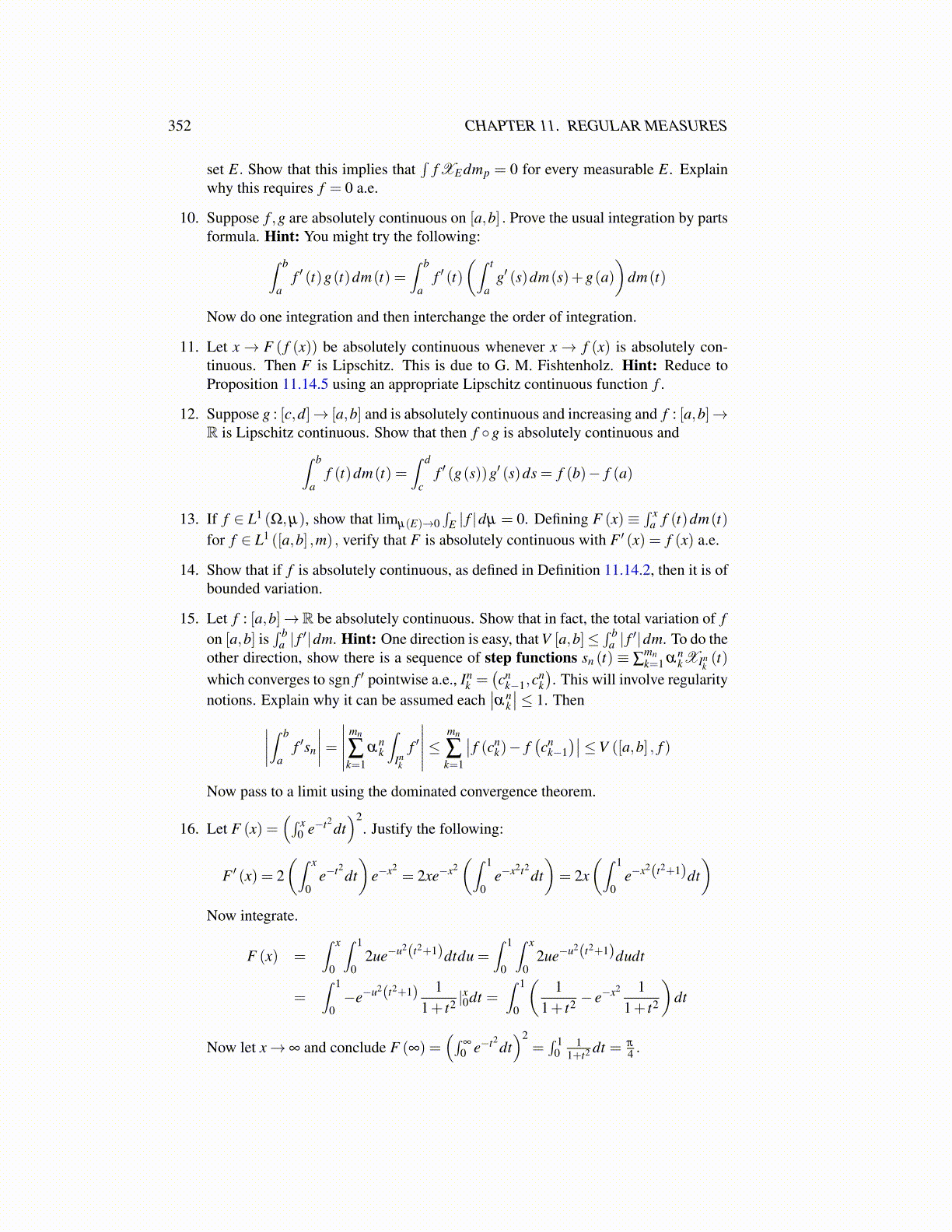
352 CHAPTER 11. REGULAR MEASURES
set E. Show that this implies that∫
f XEdmp = 0 for every measurable E. Explainwhy this requires f = 0 a.e.
10. Suppose f ,g are absolutely continuous on [a,b] . Prove the usual integration by partsformula. Hint: You might try the following:∫ b
af ′ (t)g(t)dm(t) =
∫ b
af ′ (t)
(∫ t
ag′ (s)dm(s)+g(a)
)dm(t)
Now do one integration and then interchange the order of integration.
11. Let x→ F ( f (x)) be absolutely continuous whenever x→ f (x) is absolutely con-tinuous. Then F is Lipschitz. This is due to G. M. Fishtenholz. Hint: Reduce toProposition 11.14.5 using an appropriate Lipschitz continuous function f .
12. Suppose g : [c,d]→ [a,b] and is absolutely continuous and increasing and f : [a,b]→R is Lipschitz continuous. Show that then f ◦g is absolutely continuous and∫ b
af (t)dm(t) =
∫ d
cf ′ (g(s))g′ (s)ds = f (b)− f (a)
13. If f ∈ L1 (Ω,µ), show that limµ(E)→0∫
E | f |dµ = 0. Defining F (x)≡∫ x
a f (t)dm(t)for f ∈ L1 ([a,b] ,m) , verify that F is absolutely continuous with F ′ (x) = f (x) a.e.
14. Show that if f is absolutely continuous, as defined in Definition 11.14.2, then it is ofbounded variation.
15. Let f : [a,b]→R be absolutely continuous. Show that in fact, the total variation of fon [a,b] is
∫ ba | f ′|dm. Hint: One direction is easy, that V [a,b]≤
∫ ba | f ′|dm. To do the
other direction, show there is a sequence of step functions sn (t) ≡ ∑mnk=1 αn
kXInk(t)
which converges to sgn f ′ pointwise a.e., Ink =
(cn
k−1,cnk
). This will involve regularity
notions. Explain why it can be assumed each∣∣αn
k
∣∣≤ 1. Then∣∣∣∣∫ b
af ′sn
∣∣∣∣=∣∣∣∣∣ mn
∑k=1
αnk
∫Ink
f ′∣∣∣∣∣≤ mn
∑k=1
∣∣ f (cnk)− f
(cn
k−1)∣∣≤V ([a,b] , f )
Now pass to a limit using the dominated convergence theorem.
16. Let F (x) =(∫ x
0 e−t2dt)2
. Justify the following:
F ′ (x) = 2(∫ x
0e−t2
dt)
e−x2= 2xe−x2
(∫ 1
0e−x2t2
dt)= 2x
(∫ 1
0e−x2(t2+1)dt
)Now integrate.
F (x) =∫ x
0
∫ 1
02ue−u2(t2+1)dtdu =
∫ 1
0
∫ x
02ue−u2(t2+1)dudt
=∫ 1
0−e−u2(t2+1) 1
1+ t2 |x0dt =
∫ 1
0
(1
1+ t2 − e−x2 11+ t2
)dt
Now let x→ ∞ and conclude F (∞) =(∫
∞
0 e−t2dt)2
=∫ 1
01
1+t2 dt = π
4 .